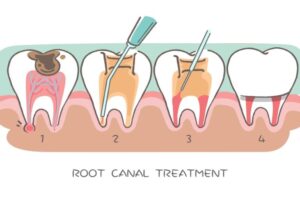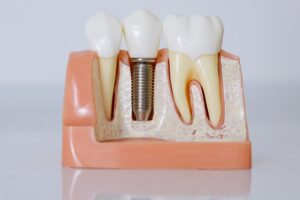
Some people may feel insecure about having a gap in their teeth, medically known as a diastema. Tooth gaps can be effectively filled with a variety of modern dental procedures, restoring the patient’s smile and self-esteem. This guide explains some of the different methods available, with Dental Panache presented as an experienced provider of these services.
Common teeth gap treatments at Dental Panache
Orthodontic treatment
- Braces: Traditional braces use metal or ceramic brackets and wires to apply gentle, continuous pressure, slowly moving teeth to close gaps. This choice works well to fill in bigger gaps and fix other alignment problems.
- Clear aligners: Clear, removable aligners offer a discreet alternative to braces. Each set is made to slowly move your teeth, which makes it a great choice for people who want a less obvious procedure.
Cosmetic solutions
- Dental bonding: A quick and affordable procedure where a tooth-colored resin is applied to the surface of the teeth, shaped to fill the gap, and then hardened with a special light. It is ideal for smaller gaps.
- Veneers: These are thin, custom-made porcelain or composite shells that are bonded to the front of your teeth. They are a long-lasting option for masking moderate gaps and other cosmetic imperfections.
Surgical and restorative options
- Frenectomy: If the gap is caused by an oversized labial frenum (the tissue connecting the upper lip to the gums), a simple surgical procedure can reduce it. A frenectomy is often combined with other treatments to ensure the gap remains closed.
- Dental implants and bridges: For gaps caused by a missing tooth, an implant or bridge can provide a permanent replacement. After being surgically placed into the jawbone, a titanium post called an implant is topped with a dental crown. A bridge consists of adjacent teeth that anchor a replacement tooth.
The best treatment for your diastema depends on its underlying cause, size, and location. An experienced dentist at Dental Panache will do a full evaluation to find the best option, which will ensure a long-lasting and attractive outcome. Check-ups and full smile makeovers are just a few of the great oral health care services that Dental Panache provides. The clinic is known for its expert and experienced dental surgeons, state-of-the-art technology, and patient-centric philosophy. The team puts an emphasis on openness, comfort, and individualized care to help you reach your smile goals. How to fill gaps in your teeth. You can use this guide as a starting point to learn how to fill in gaps in your teeth. Your path to a confident smile is unique, and a consultation with the experts at Dental Panache can help you make an informed decision for a smile you’ll love.
Understanding teeth gaps and why they occur.
Teeth gaps, known medically as diastema, are spaces between two or more teeth. While often a cosmetic concern, diastema can also be related to underlying dental health issues. You can get these gaps anywhere in your mouth, but most of the time they happen between your two upper front teeth. Dental Panache in Gurgaon is a dental clinic that offers various services, including addressing tooth gaps, filling, and other tooth gap treatment options.
Causes of tooth gaps
- Genetics: A size mismatch between the teeth and the jawbone is a major cause. If a patient’s jaw is larger than their teeth, excess space will lead to gaps. This often runs in families.
- In most people, the labial frenum—the tissue that attaches the upper lip to the gum line—is enlarged. An overgrowth of this tissue can create a separation between the two upper front teeth, causing a gap.
- When a tooth falls out of alignment, the teeth next to it might move, creating gaps in the smile that are either filled in or made wider.
- Bad habits: Things like thumb sucking and tongue thrusting can gradually wear down teeth by putting pressure on them.
- Gum disease, also called periodontitis, can make the bone that supports the teeth weak and inflamed, which can lead to loose teeth and gaps between them.
- An incorrect swallowing reflex can cause the tongue to gradually advance by pressing against the front teeth.
Impact of tooth gaps
Cosmetic:
- Self-consciousness: For certain individuals, a gap in their smile in social settings can result in feelings of embarrassment or anxiety, which in turn lowers their self-esteem.
- In certain cultures, the presence of a tooth gap is considered a symbol of good fortune or beauty, and a substantial number of individuals choose to accept it.
Dental health:
- Plaque buildup, cavities, and gum disease are more likely to occur when food gets stuck in spaces between teeth, which makes cleaning a real pain.
- When there are larger spaces between your teeth, especially your front teeth, it can be difficult to pronounce words clearly, which can lead to a lisp or other speech impediment.
- Out-of-place bite: Gaps can lead to an out-of-place bite, which can lead to jaw pain, uneven tooth wear, and other TMJ issues.
- Gum problems: The increased risk of gum irritation and inflammation from trapped food can lead to gingivitis or more serious periodontal disease if left unaddressed.
- Moving teeth: Over time, gaps can cause teeth next to each other to move, which can throw off the alignment of your whole smile.
READ MORE – The Perfect Smile Awaits: Learn About the Best Dental Clinic in Gurgaon for Total Oral Wellness
Popular teeth gap-filling options
At Gurgaon’s Dental Panache, patients can talk to experts about the best way to fill in the gap between their teeth. The appropriate option is determined by the size and cause of the gaps, as well as the patient’s aesthetic objectives and budget.
Dental Bonding
Dental bonding is a popular and easy way to close small to medium gaps.
- What it is: A tooth-colored composite resin is applied directly to the teeth, shaped to fill the space, and then hardened with a special light. After that, the dentist polishes the resin to make it look more natural.
- Pros:
- Cost-effective: It is generally one of the most affordable cosmetic dental treatments.
- Fast: The procedure is minimally invasive and typically completed in a single visit.
- Minimally invasive: Unlike other procedures, little to no enamel removal is required, and anesthesia is often not needed.
- Cons:
- Less durable: The resin material is not as strong as natural teeth or porcelain and can chip over time.
- Prone to staining: The material is more susceptible to stains from coffee, tea, and tobacco than porcelain.
Porcelain Veneers
Porcelain veneers are a great choice for people who want a solution that will last longer.
- What they are: Veneers are custom-made, ultra-thin shells of porcelain that are bonded to the front surfaces of the teeth. They can close gaps and also address issues like discoloration and minor misalignment.
- Pros:
- Very nice to look at: veneers are made to match your real teeth in color, size, and shape, so they look beautiful and real.
- Strong and not easy to stain: Porcelain is very strong and not easy to stain like composite resin.
- A properly cared-for veneer can extend its life by ten to fifteen years, or even longer.
- Cons:
- More expensive: This procedure is more expensive than dental bonding.
- When the procedure is done, a small amount of enamel is removed. This changes the natural structure of the tooth in a way that can’t be undone.
Orthodontics
For gaps that are caused by a bad bite or problems with alignment, orthodontic treatment is the only complete and long-lasting solution.
- This method uses stick-on braces or clear aligners (like Invisalign) to gradually shift the teeth into their proper positions.
- Pros:
- Comprehensive correction addresses the root cause of the gaps, improving overall bite and alignment rather than just cosmetic appearance.
- Permanent results: Following treatment, teeth are kept in their new, corrected positions, often with the assistance of a retainer.
- Cons:
- The process usually takes between a few months and a few years, which is longer than bonding or veneers.
- Costs can go up: The total cost may go up, but it depends on how bad the case is.
Understanding general teeth filling
To fix tooth decay, which is also known as cavities, people often get fillings. You can also use a tooth filling to fix teeth that have been broken by clenching, grinding, or hitting them. At Dental Panache, dental professionals in Gurgaon can determine the best course of action for your specific needs, whether for a tooth gap filling or a standard tooth filling.
What is a dental filling?
A dental filling restores a decayed tooth to its normal function and shape. The procedure involves:
- The dentist cleans the area and takes out the decayed tooth material.
- The cavity is then filled with a filling material.
- This process fills in any gaps that bacteria could have entered, stopping further decay and repairing the tooth’s structure.
Types of filling materials
The best type of filling for you will depend on several things, such as where and how bad the decay is, your budget, and your concerns about how the filling will look.
- Composite resin:
- What it is: A tooth-colored material made from a mix of glass or quartz.
- It was picked because it looks good and can be made to match your teeth, which makes it perfect for places that people will see.
- Considerations: It is less durable than amalgam and may not be suitable for very large cavities or those in areas with heavy chewing pressure.
- Amalgam (silver) fillings:
- What it is: A durable and inexpensive filling made from a mixture of metals, including silver, copper, and mercury.
- Why it’s chosen: Its strength makes it ideal for back teeth, such as molars, that endure heavy chewing.
- Considerations: Amalgam is silver in color, so it’s more noticeable than composite resin and is not typically used for front teeth.
- Porcelain fillings (inlays/onlays):
- What it is: Also called ceramic fillings, these are custom-made in a laboratory and bonded to the tooth.
- Why it’s chosen: Porcelain is very durable and stain-resistant and can be matched perfectly to your natural tooth color.
- Considerations: They are usually more expensive and may necessitate several visits to complete.
What to expect
The process for getting a dental filling is straightforward. A local anesthetic will be used to numb the area by your dentist first. This will make you feel better. The decayed tissue is then removed using a drill or other instrument. The space is cleaned, and the chosen filling material is applied and polished. For composite fillings, a special curing light is used to harden the layers of material.
Aftercare typically involves avoiding chewing on the filled tooth until any numbness wears off, especially with amalgam fillings. It’s recommended to avoid sticky, firm, or very hot or cold foods for the first few days if you experience sensitivity. It is important to brush and floss your teeth every day to keep your fillings and teeth healthy.
What to expect with teeth gap treatment
The teeth gap filling treatment process at Dental Panache in Gurgaon is personalized, transparent, and patient-focused. Here are some things that will happen as you work to improve your smile.
Initial consultation with Dental Panache
A thorough first consultation is the first step toward a new smile.
- A dentist will check your teeth, gums, and bite as part of a full dental exam. These tools, like digital X-rays and scanners that can go inside your mouth, might help them see your mouth better.
- Talking about your goals: Your dentist will listen to what you want to change about your looks and what you want to get out of the teeth gap treatment.
- Personalized treatment plan: The dentist will make a personalized treatment plan based on the exam and your input. This will include the suggested ways to fill in gaps between teeth, like dental bonding, porcelain veneers, or braces. The plan will also include the procedure, timeline, and costs.
The treatment process
The specific steps will depend on the treatment plan developed during your consultation.
- For dental bonding: The procedure is typically completed in a single visit. The dentist will:
- Clean and prepare the tooth surface.
- Put the composite resin on the gap and shape it to fit.
- Use a special light to harden the material.
- Polish the final restoration to blend seamlessly with your natural teeth.
- For porcelain veneers: This process generally takes two or more appointments.
- The dentist will get your teeth ready for the crown by removing a small amount of enamel and using an intraoral scanner to make precise impressions. While your custom veneers are being made in a lab, you may be given temporary veneers to wear.
- In the next appointment, the custom-made veneers are bonded to your teeth, and the fit and shade are perfected.
- For orthodontics (braces or aligners): This is a multi-step process that can take several months to a couple of years.
- The dentist will take impressions and images to plan the tooth movements.
- Your dentist will fit your braces or give you a series of clear aligners.
- Following up with you will be done at set times to see how things are going and make any needed changes.
Our technology
Dental Panache invests in advanced dental technology to ensure your treatment is as comfortable, precise, and efficient as possible.
- Digital X-rays: These give doctors high-resolution pictures of your teeth and jaws while exposing you to very little radiation.
- Intraoral scanners: These high-tech handheld scanners make digital impressions of your teeth so you don’t have to use messy and uncomfortable molds.
- Digital smile design: This advanced software allows you to visualize your potential new smile before treatment even begins, helping you make informed decisions.
- Laser dentistry: For many procedures, Dental Panache uses modern dental lasers, which cause less pain and help the body heal faster than older methods.
READ MORE – Experience Premium Dental Care: Implants to Root Canal Treatment in Gurgaon
Conclusion
Addressing dental concerns like tooth gaps and cavities is crucial for both oral health and confidence. There are several good ways to close up gaps between teeth. Three of these are dental bonding, which is quick and doesn’t hurt; porcelain veneers, which look good and last a long time; and orthodontics, which makes everything better. Modern dentistry offers various good materials for filling teeth, ranging from strong amalgam to cosmetic composite resin. This means that each tooth can get a unique treatment plan based on its location and level of decay.
At Dental Panache, our mission is to provide personalized and exceptional dental care. We use cutting-edge technology and put the patient first to make sure that each person gets a treatment plan that is specifically made for their needs. Whether you are seeking a complete smile transformation with teeth gap treatment or routine care for a cavity, our skilled professionals are committed to providing results with care and accuracy.
Are you ready to get a perfect smile? Schedule your consultation with the experts at Dental Panache today by calling 07290073613 or visiting our website.






